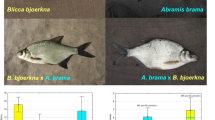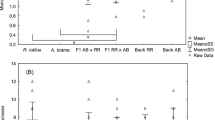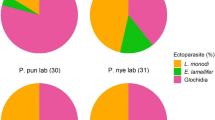Summary
This paper is the second of three studies of a natural hybrid,Rutilus rubilioxAlburnus alburnus found in Lake Mikri Prespa in Northern Greece. It compares the parasite load of the hybrid to that of its parents, focussing onDactylogyrus spp.,Diplozoon sp.,Bolbophorus confusus andPomphorhynchus bosniacus. The hybrid's gill tissue is parasitised almost exclusively by the parentalDactylogyrus. It follows that theDactylogyrus group constitutes an excellent biological marker for hybridisation. Furthermore, the hybrid is characterised by the following two features: 1. high susceptibility to parasitic infections, 2. important role of ecological components in the recruitment of parasites: for monoxenous parasites (Dactylogyrus spp.), the spatial position of the hybrid and for heteroxenous parasites (P. bosniacus), the trophic position. The parasitology of this particular hybrid may be useful as a model for the properties and fitness of hybrids in general.
Similar content being viewed by others
References
Banarescu P (1964) Pisces Osteichthyes. Fauna Rep Pop Rom 13:961 p
Barry JM, O'Rourke FJ (1959) Species specificity of mucus. Nature (London) 184:2039
Berrebi P, Le Brun N, Renaud F, Lambert A (1986) Hybridation interspecifique de deux Cyprinidae (GenreBarbus). Conséquences sur la spécificité parasitaire deDiplozoon gracile (Monogenea). Actes du Colloque National du CNRS «Biologie des Populations». Sept. 1986, pp 179–180
Bliss EI, Fischer RA (1953) Fitting the negative binomial distribution. Biometrics 9:176–200
Bohl E (1980) Diel pattern of distribution and feeding in planktivorous fish. Oecologia (Berlin) 44:368–375
Bona FV (1975) Etude critique et taxonomique des Dilepididae Fuhm, 1907 (Cestoda) parasites des Ciconiformes. Considérations sur la spécificité parasitair et la spéciation. Monit Zool Ital Monogr, 750 p
Bychowsky BE (1957) Monogenetic trematodes. Their systematics and phylogeny. Translated from Russian by the American Institute of Biological Sciences 1961:627 p
Calderoni P (1965) Nouvelles recherches sur l'alimentation deRutilus rubilio Bp dans de lac Trasiméne. Proc Gen Fish Coun Medit 8:133–137
Carton Y (1968a) Spécificité parasitaire deSebelliphilus sarsi, parasite deSpirographis spallanzani. III. Mise en évidence d'une attraction biochimique du copépode par l'Annélide. Arch Zool Exp Gén Notes Rev 109:123–144
Carton Y (1968b) Spécificité parasitaire deSebelliphilus sarsi, parasite deSpirographis spallanzani. IV. Etude biochemique des hôtes et de leurs sécrétions. Arch Zool Exp Gén Notes Rev 109:269–286
Chourrout D, chevassus B, Guyomard R (1986) L'amélioration génétique des Poissons. Recherche 180:1028–1038
Crivelli AJ (1984) Lakes — Fisheries. In: Integrated environmental study of Prespa National Parc, Greece. Final report 205 p. Commission of the European Communities DG XI:49–86, 144–155
Crivelli AJ, Dupont F (1987) Biometrical and biological features ofAlburnus alburnusxRutilus rubilio natural hybrid of lake Prespa, Northern Greece. J Fish Biol 31:721–733
Daoulas CC, Economidis PS (1984) The feeding ofRutilus rubilic (Bonaparte) (Pisces, Cyprinidae) in lake Trichonis, Greece. Cybium 8:29–38
Di Conza JJ, Halliday WJ (1971) Relationship of catfish serum antibodies to immunoglobulin in mucus secretions. Aust J Exp Biol Med Sci 49:517–519
Dupont F, Lambert A (1986) Etude des communautés de Monogènes Dactylogyridae parasites de Cyprinidae du lac Mikri Prespa (N de la Grèce). Description de trois nouvelles espèces chez unBarbus endémique:Barbus cyclolepis prespensis Karaman, 1924. Ann Parasit Hum Comp 61:597–616
Esch GW, Hasen TC, Aho JM (1977) Parasitism and r- and K-selection. In: Regulation of parasite populations. Academic Press, London, pp 9–62
Fletcher TC, Grant PT (1969) Immunoglobulins in the serum and mucus of the plaice, (Pleuronectes platessa). Biochem J 115, 65 p
Halvorsen O (1969) Studies of the helminth fauna of Norway XIII:Diplozoon paradoxum Nordmann 1832, from Roach, Rutilus rutilus Bream,Abramis brama (L) and hybrid of roach and bream. Its morphological adaptibility and host specificity. Nytt Mag Zool 17:93–103
Hristovski ND (1976) The helminth fauna of the cyprinid fish from Prespa lake. Acta Parasit Jugosl 7:21–28
Kearn GC (1976) Body surface of fishes. In: Kennedy CR (ed) Ecological aspects of parasitology. North-Holland Publishing, Amsterdam, pp 185–208
Kitchell JF, Stein RS, Knezevic B (1978) Utilization of filamentous algae by fishes in lake Skadar, Yugoslavia. Verh Int Verein Limnol 20:2159–2165
Le Brun N, Renaud F, Lambert A (1985) Le problème de l'espèce chezDiplozoon, (Plathelminthe, Monogenea, Polyopisthocotylea). Bull Soc Fr Parasitol 1:105–109
Molnar K, Bakos J, Krasznai Z (1984) Parasites of hybrid fishes. Parasitol Hung 17:29–34
Nybelin O (1936) Kleine Beiträge zur Kenntnis des Dactylogyren. Ark Zool A29:1–29
O'Rourke FJ (1961) Presence of blood antigens in fish mucus and its possible parasitological significance. Nature (London) 189:943
Pepin H, Moreau G, Marrazzoto S, Géry J (1970) Biometrie d'un hybride naturel de Poissons Cyprinidae, la brême de Buggenhagen. Ann Hydrobiol 1:43–54
Rhee JK, Baek BK, Ahn BZ, Park YJ (1979) The wormicidal substances of fresh water fish onClonorchis sinesis. I. Preliminary research on the wormicidal substance from muccous-substance ofCarassius carassius. Korean J Parasitol 17:121–126
Sage RD, Heyneman D, Lim K-C, Wilson AC (1986) Wormy mice in a hybrid zone. Nature (London) 324:60–63
Spillmann Ch J (1961) Faune de France. Poissons d'eau douce. Ed Le Chevalier, Paris 65:303 p
Vollestad LA (1985) Resource partitioning of roachRutilus rutilus and bleakAlburnus alburnus in two eutrophic lakes in SE Norway. Holartic Ecology 8:88–92
Author information
Authors and Affiliations
Rights and permissions
About this article
Cite this article
Dupont, F., Crivelli, A.J. Do parasites confer a disadvantage to hybrids?. Oecologia 75, 587–592 (1988). https://doi.org/10.1007/BF00776424
Received:
Issue Date:
DOI: https://doi.org/10.1007/BF00776424




